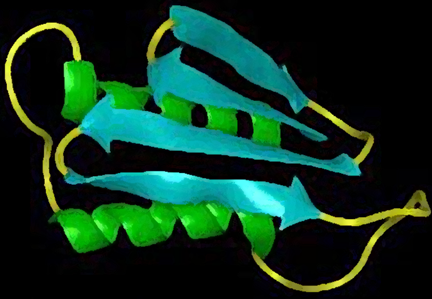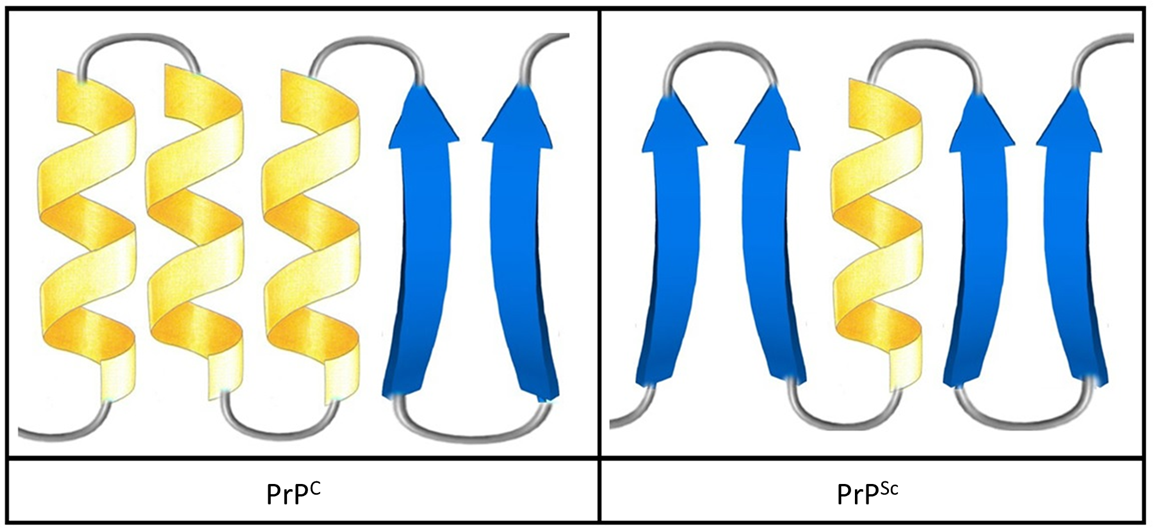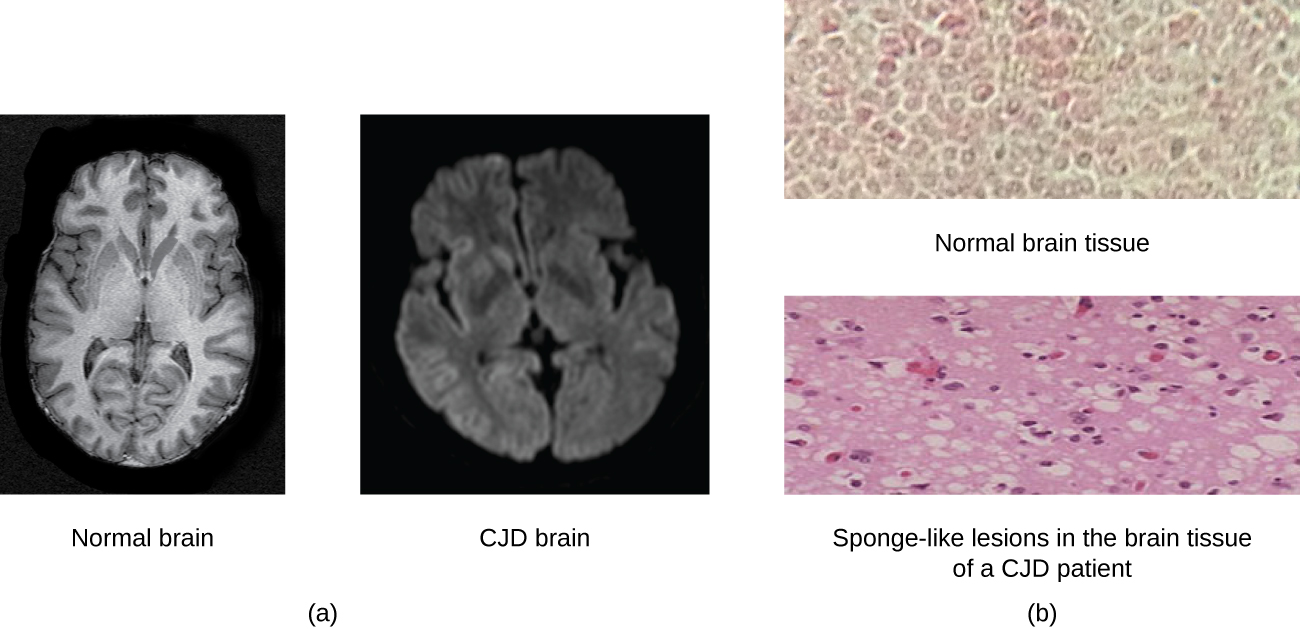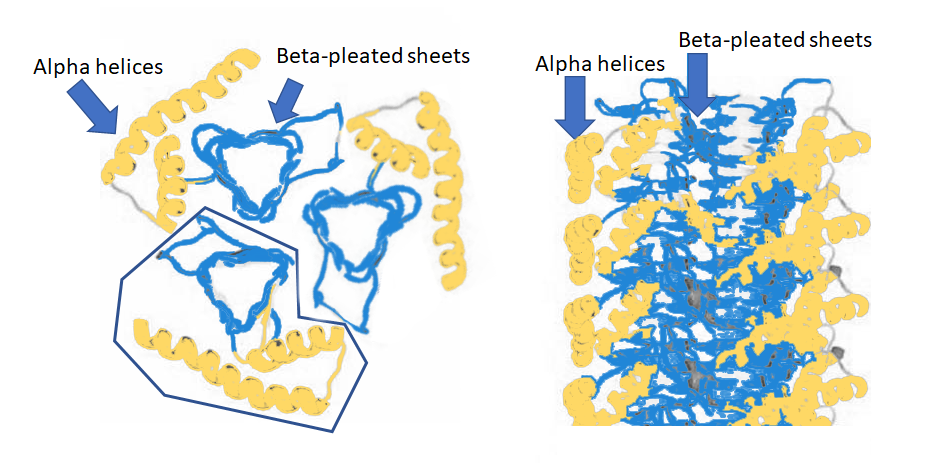15.3.2: vCJD
- Page ID
- 42683
\( \newcommand{\vecs}[1]{\overset { \scriptstyle \rightharpoonup} {\mathbf{#1}} } \)
\( \newcommand{\vecd}[1]{\overset{-\!-\!\rightharpoonup}{\vphantom{a}\smash {#1}}} \)
\( \newcommand{\id}{\mathrm{id}}\) \( \newcommand{\Span}{\mathrm{span}}\)
( \newcommand{\kernel}{\mathrm{null}\,}\) \( \newcommand{\range}{\mathrm{range}\,}\)
\( \newcommand{\RealPart}{\mathrm{Re}}\) \( \newcommand{\ImaginaryPart}{\mathrm{Im}}\)
\( \newcommand{\Argument}{\mathrm{Arg}}\) \( \newcommand{\norm}[1]{\| #1 \|}\)
\( \newcommand{\inner}[2]{\langle #1, #2 \rangle}\)
\( \newcommand{\Span}{\mathrm{span}}\)
\( \newcommand{\id}{\mathrm{id}}\)
\( \newcommand{\Span}{\mathrm{span}}\)
\( \newcommand{\kernel}{\mathrm{null}\,}\)
\( \newcommand{\range}{\mathrm{range}\,}\)
\( \newcommand{\RealPart}{\mathrm{Re}}\)
\( \newcommand{\ImaginaryPart}{\mathrm{Im}}\)
\( \newcommand{\Argument}{\mathrm{Arg}}\)
\( \newcommand{\norm}[1]{\| #1 \|}\)
\( \newcommand{\inner}[2]{\langle #1, #2 \rangle}\)
\( \newcommand{\Span}{\mathrm{span}}\) \( \newcommand{\AA}{\unicode[.8,0]{x212B}}\)
\( \newcommand{\vectorA}[1]{\vec{#1}} % arrow\)
\( \newcommand{\vectorAt}[1]{\vec{\text{#1}}} % arrow\)
\( \newcommand{\vectorB}[1]{\overset { \scriptstyle \rightharpoonup} {\mathbf{#1}} } \)
\( \newcommand{\vectorC}[1]{\textbf{#1}} \)
\( \newcommand{\vectorD}[1]{\overrightarrow{#1}} \)
\( \newcommand{\vectorDt}[1]{\overrightarrow{\text{#1}}} \)
\( \newcommand{\vectE}[1]{\overset{-\!-\!\rightharpoonup}{\vphantom{a}\smash{\mathbf {#1}}}} \)
\( \newcommand{\vecs}[1]{\overset { \scriptstyle \rightharpoonup} {\mathbf{#1}} } \)
\( \newcommand{\vecd}[1]{\overset{-\!-\!\rightharpoonup}{\vphantom{a}\smash {#1}}} \)
\(\newcommand{\avec}{\mathbf a}\) \(\newcommand{\bvec}{\mathbf b}\) \(\newcommand{\cvec}{\mathbf c}\) \(\newcommand{\dvec}{\mathbf d}\) \(\newcommand{\dtil}{\widetilde{\mathbf d}}\) \(\newcommand{\evec}{\mathbf e}\) \(\newcommand{\fvec}{\mathbf f}\) \(\newcommand{\nvec}{\mathbf n}\) \(\newcommand{\pvec}{\mathbf p}\) \(\newcommand{\qvec}{\mathbf q}\) \(\newcommand{\svec}{\mathbf s}\) \(\newcommand{\tvec}{\mathbf t}\) \(\newcommand{\uvec}{\mathbf u}\) \(\newcommand{\vvec}{\mathbf v}\) \(\newcommand{\wvec}{\mathbf w}\) \(\newcommand{\xvec}{\mathbf x}\) \(\newcommand{\yvec}{\mathbf y}\) \(\newcommand{\zvec}{\mathbf z}\) \(\newcommand{\rvec}{\mathbf r}\) \(\newcommand{\mvec}{\mathbf m}\) \(\newcommand{\zerovec}{\mathbf 0}\) \(\newcommand{\onevec}{\mathbf 1}\) \(\newcommand{\real}{\mathbb R}\) \(\newcommand{\twovec}[2]{\left[\begin{array}{r}#1 \\ #2 \end{array}\right]}\) \(\newcommand{\ctwovec}[2]{\left[\begin{array}{c}#1 \\ #2 \end{array}\right]}\) \(\newcommand{\threevec}[3]{\left[\begin{array}{r}#1 \\ #2 \\ #3 \end{array}\right]}\) \(\newcommand{\cthreevec}[3]{\left[\begin{array}{c}#1 \\ #2 \\ #3 \end{array}\right]}\) \(\newcommand{\fourvec}[4]{\left[\begin{array}{r}#1 \\ #2 \\ #3 \\ #4 \end{array}\right]}\) \(\newcommand{\cfourvec}[4]{\left[\begin{array}{c}#1 \\ #2 \\ #3 \\ #4 \end{array}\right]}\) \(\newcommand{\fivevec}[5]{\left[\begin{array}{r}#1 \\ #2 \\ #3 \\ #4 \\ #5 \\ \end{array}\right]}\) \(\newcommand{\cfivevec}[5]{\left[\begin{array}{c}#1 \\ #2 \\ #3 \\ #4 \\ #5 \\ \end{array}\right]}\) \(\newcommand{\mattwo}[4]{\left[\begin{array}{rr}#1 \amp #2 \\ #3 \amp #4 \\ \end{array}\right]}\) \(\newcommand{\laspan}[1]{\text{Span}\{#1\}}\) \(\newcommand{\bcal}{\cal B}\) \(\newcommand{\ccal}{\cal C}\) \(\newcommand{\scal}{\cal S}\) \(\newcommand{\wcal}{\cal W}\) \(\newcommand{\ecal}{\cal E}\) \(\newcommand{\coords}[2]{\left\{#1\right\}_{#2}}\) \(\newcommand{\gray}[1]{\color{gray}{#1}}\) \(\newcommand{\lgray}[1]{\color{lightgray}{#1}}\) \(\newcommand{\rank}{\operatorname{rank}}\) \(\newcommand{\row}{\text{Row}}\) \(\newcommand{\col}{\text{Col}}\) \(\renewcommand{\row}{\text{Row}}\) \(\newcommand{\nul}{\text{Nul}}\) \(\newcommand{\var}{\text{Var}}\) \(\newcommand{\corr}{\text{corr}}\) \(\newcommand{\len}[1]{\left|#1\right|}\) \(\newcommand{\bbar}{\overline{\bvec}}\) \(\newcommand{\bhat}{\widehat{\bvec}}\) \(\newcommand{\bperp}{\bvec^\perp}\) \(\newcommand{\xhat}{\widehat{\xvec}}\) \(\newcommand{\vhat}{\widehat{\vvec}}\) \(\newcommand{\uhat}{\widehat{\uvec}}\) \(\newcommand{\what}{\widehat{\wvec}}\) \(\newcommand{\Sighat}{\widehat{\Sigma}}\) \(\newcommand{\lt}{<}\) \(\newcommand{\gt}{>}\) \(\newcommand{\amp}{&}\) \(\definecolor{fillinmathshade}{gray}{0.9}\)

Pathogen
- Caused by the PrPsc protein, a misfolded form of the normal brain protein PrPc
- PrPc and PrPsc have the same amino acid sequence (primary structure); they are just folded in different ways (secondary and teriary structure)
- Pathogenic form of the protein (PrPsc ) primarily consists of beta-pleated sheets (Figure \(\PageIndex{1}\)) and is extremely stable, surviving cooking, stomach acid, and disinfectants
- Protein (PrPc) is normally produced in the brain
- See Prions in Chapter 2 for more information

Figure \(\PageIndex{1}\): Simplified schematic of normal PrP (PrPC, left) and pathogenic PrP (PrPSc, right). Alpha helices are colored yellow and beta-pleated sheets are colored blue("File:PRPCvsPRPSC.jpg" by BQUB13-Hcastillo is licensed under CC BY-SA 3.0)
Habitat
- Normal protein is found in the brains of all mammals
- Misfolded, pathogenic form found in the central nervous system of diseased individuals
Source
- Pathogenic form of the protein is ingested in contaminated meat, most commonly beef from cattle suffering from Bovine Spongiform Encephalopathy (BSE)
- Deer suffering from Chronic Wasting Disease could also be a source
Epidemiology
- Variant Creutzfeld-Jakob Disease (vCJD) is so called because it affects younger people without a family history, as opposed to sCJD which causes dementia in older people or fCJD which is inherited
- Can take 10 or more years to develop following ingestion of contaminated meat
- Came to public notice after several cases emerged in Britain and became known as "Mad Cow Disease"
Clinical Disease
- A spongiform encephalopathy, a neurodegenerative condition resulting from destruction of brain tissue (Figure \(\PageIndex{2}\))
- Causes brain damage, loss of motor coordination, and dementia.
- Infected individuals are mentally impaired and become unable to move or speak.
- There is no cure, and the disease progresses rapidly, eventually leading to death within a few months or years.

Primary Virulence Factors
- Protein stability: the PrPsc protein remains intact through disinfection procedures, cooking, and ingestion. Once ingested it leaves the digestive tract and eventually localizes in the brain.
- Catalyzes protein misfolding: when PrPsc interacts with PrPc it catalyzes the re-folding of the protein to the pathogenic form
- Protein clumping: the PrPsc proteins clump together (Figure \(\PageIndex{3}\)), similar to amyloid plaques found in Alzheimer's disease, disrupting the neuron function and eventually killing the affected cell. The released PrPsc then enters neighboring cells, killing those in turn. This results in the sponge-like appearance of brains affected by vCJD (Figure \(\PageIndex{2}\))

Figure \(\PageIndex{3}\): Interaction of PrPSc proteins. Left: Three proteins binding (one protein, lower left, is outlined). Interactions among the hydrophobic beta sheets hold the proteins together. Right: multiple sets of three proteins stacking to form clumps. Note the beta sheets on the inside and alpha helices on the outside. (Adapted from "File:Model of a three dimensional structure for PrPSc.jpg" by Kupfer, L; Hinrichs, W; Groschup, M.H. is licensed under CC BY-SA 2.5)
Additional Information:
- Prions, Chapter 2
- https://www.cdc.gov/prions/vcjd/index.html

